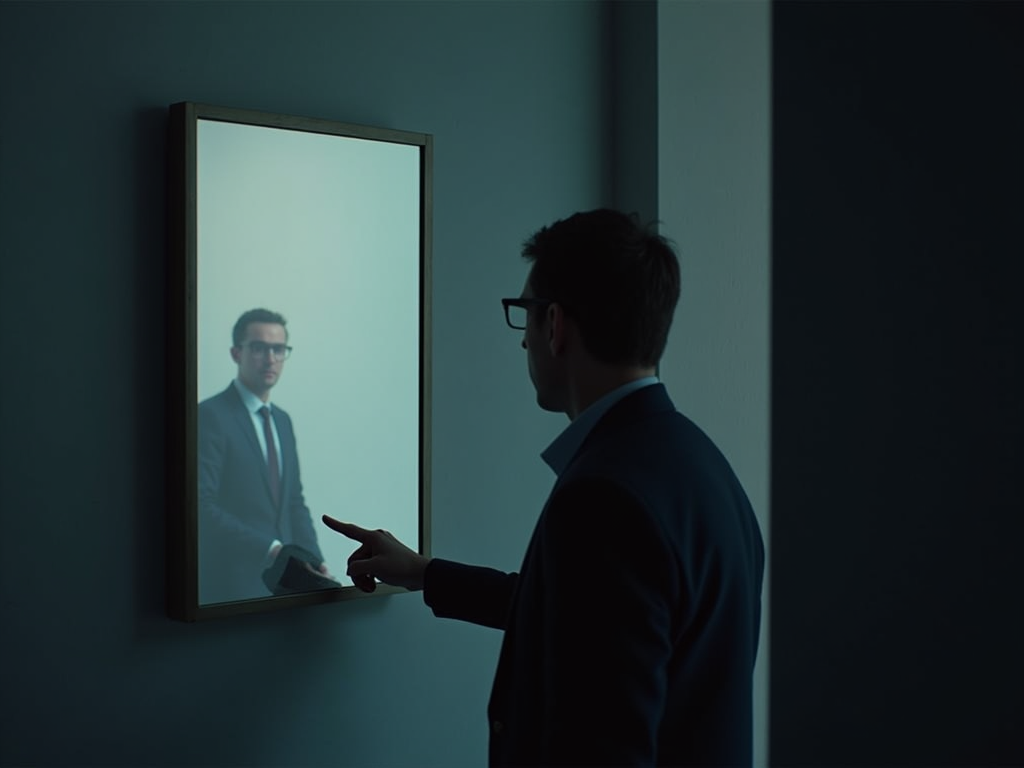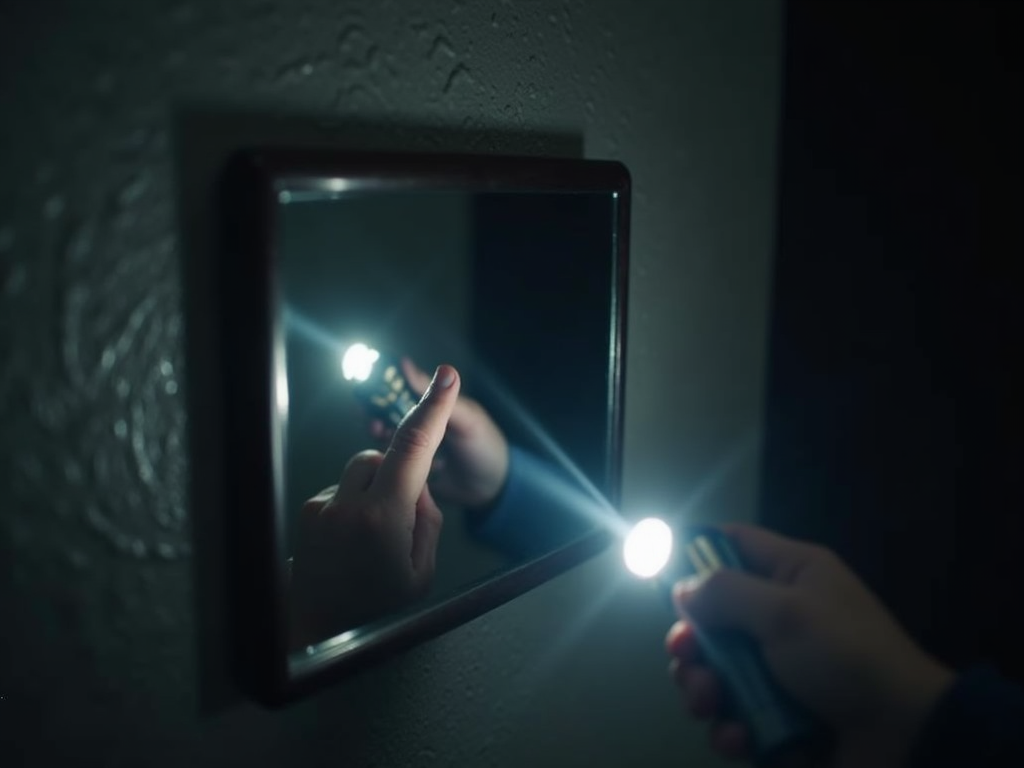
A two-way mirror looks like a typical mirror on one side but allows someone to observe from the opposite side. It’s crucial to identify these mirrors due to privacy concerns. Recognizing how they interact with light, sound, and their construction allows for simple tests to figure out if a mirror is standard or intended for two-way observation.
Key Takeaways
- A two-way mirror reflects some light but remains dependent on lighting differences between the two sides for visibility.
- Using a fingernail test might help. If your finger and its reflection touch with no visible gap, the mirror could be two-way.
- A flashlight test works well in a dark room. Shine the light on the mirror—if you notice objects or light coming through, the mirror might allow observation.
- Tapping on the mirror might hint at its type. A two-way mirror could sound hollow or feel less sturdy compared to regular ones.
- If you suspect one, approach property management or local authorities to address any potential privacy violations.
The Quickest Way to Spot a Two-Way Mirror
A two-way mirror has a partially reflective surface, tricking one side into thinking it’s just a regular mirror while allowing someone on the other side to observe. These mirrors, often used for surveillance or observation, create privacy concerns since they give an illusion of security when there’s far more visibility than expected.
The key difference lies in how they handle light. Unlike regular mirrors, which have a fully reflective backing that blocks all light, a two-way mirror allows some light to pass through. This is why lighting on either side can drastically affect what’s visible. Usually, the brighter side appears as a mirror, while the darker side functions as a viewing space.
How to Check for a Two-Way Mirror
Want to check for one? Follow these simple steps:
- Place your finger against the glass. If there’s no gap between your finger and its reflection, it might be a two-way mirror.
- Observe the lighting conditions: If the room on your side is significantly brighter than the other side, you might not detect it easily.
- Try knocking on the surface. A two-way mirror might sound hollow compared to the solid backing of a standard mirror.
- Look for a space behind the mirror. If you can, check for any gaps or empty areas behind the surface where someone could be observing.
Always stay cautious in unknown environments, especially in public bathrooms, changing rooms, or rented locations like hotels. If you suspect a two-way mirror, it’s always better to address it with the property management or local authorities.
Simple Tests You Can Do Immediately
The fingernail test is a quick and simple way to check your mirror. Gently press your fingernail against the mirror’s surface. If there’s a noticeable gap between your nail and its reflection, the mirror is likely standard. However, if your nail and its reflection seem to touch directly, it might be two-way. I’ll be honest—this test isn’t foolproof, so it’s worth combining it with other methods.
Another practical approach is the lighting test. Turn off all the lights in the room, leaving it completely dark. Grab a flashlight and shine it directly at the mirror. If it’s an ordinary mirror, you’ll just see the reflected light. But, if there’s light bleeding through, or you can make out a brighter area or objects behind the mirror, it’s likely two-way. Always trust what you observe and try these tests together for better accuracy.

Using Sound to Uncover Hidden Surveillance
Tapping on the mirror can give helpful clues. A regular mirror is usually backed securely by a solid wall, so it responds with a dull, flat sound. A two-way mirror, on the other hand, might have open space or a hollow area behind it to allow for observation, so its sound may feel lighter or more echo-like.
However, this isn’t guaranteed. Sometimes, poor wall construction or the backing of a regular mirror can mimic the hollow sound of a two-way design. Additionally, a robustly secured two-way mirror could dull the sound. It’s worth combining this method with other approaches for better results. Listening for a difference is just one way to figure things out, not a guaranteed test on its own.
Why Two-Way Mirrors Exist (And Where They Are Found)
Two-way mirrors are used in specific settings where observation is key. They’re commonly found in police interrogation rooms, allowing investigators to observe without being seen. These mirrors provide an unobtrusive way to monitor subjects while maintaining control of the environment.
Retail stores sometimes use them in security rooms for discreet shoplifting prevention. They let staff keep an eye on suspicious activity while remaining out of view. In research facilities, especially psychological or behavioral studies, two-way mirrors play a big role in studying participants without interfering with their actions.
However, the use of these mirrors raises privacy concerns. While they’re valuable for surveillance and research, they require ethical limits. Permission and clear guidelines should guide their installation, particularly in private areas. Knowing where they might be used—legitimately or otherwise—helps maintain awareness and accountability.
When to Call in the Experts
If you’re seriously concerned about a mirror being a two-way mirror, especially in places like dressing rooms, bathrooms, or other private spaces, it’s smart to involve professionals. Security specialists or even local law enforcement can assess the situation more effectively than a DIY approach.
They’ve got access to tools like thermal imaging and advanced reflective surface analyzers that can identify hidden surveillance technology. These methods go beyond the flashlight test or finger reflection check you might have tried yourself. A trained expert brings both precision and experience, ensuring that any privacy concerns are addressed thoroughly.
When the stakes are high, like in workplaces or rented spaces, getting help is the most secure way to confirm your suspicions. Always prioritize safety and act swiftly if something doesn’t feel right.
Protecting your privacy in everyday settings is essential in today’s world. Being mindful of your surroundings can help prevent unwanted breaches of your personal space.
Being Cautious in Unfamiliar Places
Unfamiliar places like changing rooms, restrooms, and hotel rooms require extra vigilance. Though two-way mirrors are rare, they are not impossible to encounter. You should never assume a reflective surface is what it appears to be until you’ve confirmed it.
Testing Potential Two-Way Mirrors
- Place your fingertip against the surface. If there’s a noticeable gap between your fingertip and its reflection, it’s likely a standard mirror. If the reflection touches directly without a gap, it could be a two-way mirror.
- Shine a flashlight directly at the mirror. If you can see the room behind it, there’s a chance it’s two-way glass.
- Knock on the surface. An ordinary mirror will sound solid, while a two-way mirror might produce a hollow sound.
Taking Action When Something Feels Off
If something seems suspicious, it’s important to take it seriously. Reporting anything out of the ordinary to local authorities not only protects you but also safeguards others who may use the same space. Treating any questionable reflective surface as potentially two-way ensures that you err on the side of caution.
Staying Vigilant
Above all, always make privacy a priority. These small precautions go a long way in keeping personal spaces secure. Awareness and quick action are your best defenses when you encounter a situation that doesn’t feel right.
Sources:
wikihow – Detect a Two-Way Mirror
Snopes – Two-Way Mirror Test
Lifehacker – How to Spot a 2-Way Mirror and Why It Matters
